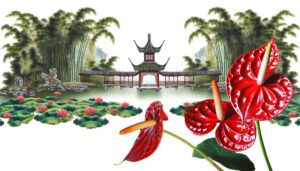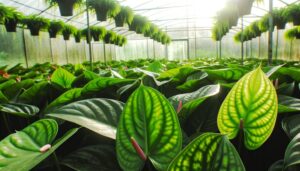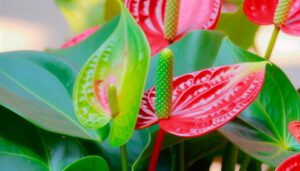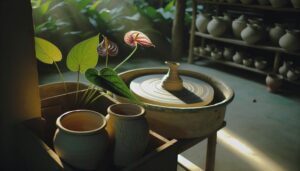Identifying and Treating Frost Burn on Anthurium Plants
To identify frost burn on Anthurium plants, look for brown or blackened leaf edges, brittle leaves, and water-soaked spots turning necrotic. Causes include exposure to freezing temperatures and ice crystals puncturing cell walls.
Immediately relocate the plant to a warmer area, inspect roots, increase humidity, and avoid fertilizing. Trim severely damaged leaves with sterilized scissors and provide indirect, bright light.
To prevent future damage, maintain stable temperatures, use protective coverings, and monitor humidity. Adopt these best practices to guarantee your Anthurium thrives, and there's more to explore for all-encompassing care techniques.
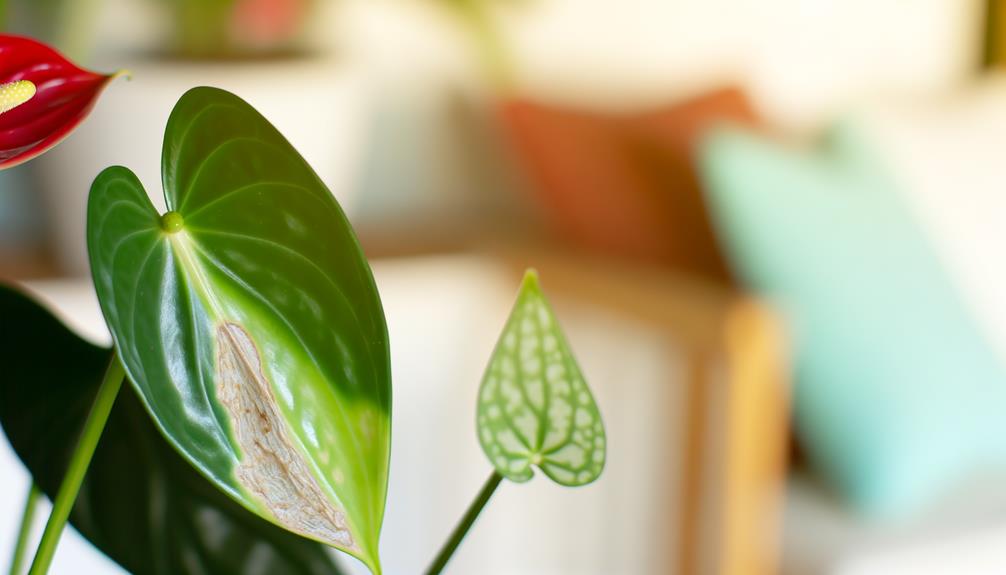
Key Takeaways
- Relocate the Anthurium plant to a warmer area immediately to prevent further frost damage.
- Trim severely damaged and necrotic leaves using sterilized scissors to prevent infection.
- Increase humidity levels around the plant to aid recovery and prevent further desiccation.
- Avoid direct sunlight and provide bright, indirect light to support the plant's recovery.
- Monitor the plant's roots for frostbite and avoid fertilizing until the plant stabilizes.
Signs of Frost Burn
Frost burn on Anthurium plants typically manifests as brown or blackened leaf edges, indicating cellular harm due to freezing temperatures. You'll notice that the affected leaves may become brittle and desiccated, as the frost disrupts the vascular tissues, impairing water and nutrient transport.
In severe cases, entire leaves can wilt and collapse. Look for a water-soaked appearance on the leaf surface, which later turns necrotic. Additionally, check for uneven discoloration, as frost harm doesn't uniformly affect all parts of the leaf.
To assess the extent of the damage, gently touch the leaves; they may feel mushy or stiff. Early identification is essential, so regularly inspect your Anthurium, especially after exposure to cold conditions, to mitigate further harm.
Causes of Frost Damage
Exposure to freezing temperatures is the primary cause of frost damage in Anthurium plants, disrupting their cellular integrity and leading to visible tissue harm. When temperatures fall below the plant's best range, the water inside the cells can freeze, forming ice crystals that puncture cell walls. This cellular rupture results in the characteristic blackened, wilted leaves you've observed.
Additionally, rapid temperature fluctuations can worsen this damage. Poorly insulated pots and inadequate shelter during cold snaps also contribute to the issue. Even brief exposure to frost can be harmful.
To minimize risk, optimize your Anthurium is kept in a stable, warm environment, away from drafty windows or unheated spaces, particularly during colder months.
Immediate Actions to Take
Upon identifying frost damage on your Anthurium, immediately relocate the plant to a warmer, sheltered area to prevent further cellular damage and facilitate recovery. Guarantee the temperature remains consistently above 55°F (13°C).
Avoid direct sunlight, as stressed plants are more susceptible to photodamage. Inspect the roots for any signs of frostbite; if roots appear mushy or discolored, avoid watering until they're assessed further.
Gently remove any ice crystals from the leaves using a soft cloth. Increase humidity around the plant using a humidifier or a pebble tray, maintaining levels between 70-80%.
Refrain from fertilizing at this stage, as the plant's metabolism needs time to stabilize. Monitor the plant closely for progression or improvement in symptoms.
Treatment Methods
Once you've stabilized the immediate conditions, implement specific treatment methods to aid the recovery of your frost-damaged Anthurium. First, trim any severely damaged leaves to prevent further strain. Use sterilized scissors to avoid infection. Next, boost humidity levels around the plant by misting or using a humidity tray. This helps in lessening transpiration strain. Finally, make sure the Anthurium receives indirect, bright light. Avoid direct sunlight, as it can worsen damage.
| Action | Purpose | Emotional Impact |
|---|---|---|
| Trim damaged leaves | Prevent further strain | Relief from deterioration |
| Boost humidity | Lessen transpiration strain | Comfort from nurturing |
| Adjust light levels | Avoid further damage | Hope for recovery |
These steps will optimize your plant's healing process.
Prevention Tips
To prevent frost burn on your Anthurium plants, you must focus on maintaining best temperatures, using protective coverings, and considering indoor relocation.
Keep the ambient temperature stays above 60°F (15°C) to safeguard your plants from cold stress. Additionally, utilize frost cloths or bring the plants indoors during cold spells to provide extra protection.
Optimal Temperature Maintenance
Maintaining a perfect temperature range between 60-85°F is important to prevent frost burn on your Anthurium plants. You should monitor ambient temperatures closely, especially during colder months.
Employ a digital thermometer for accuracy, making sure it's placed near the plant's foliage. If temperatures drop below 60°F, use a space heater to maintain warmth, or relocate plants to a warmer indoor environment. Avoid placing Anthuriums near drafty windows or external doors where temperature fluctuations are common.
Consistent temperatures are crucial; sudden drops can stress the plant, making it susceptible to frost burn. Additionally, ensure adequate humidity levels, around 70-80%, as low humidity can worsen temperature stress.
Implementing these measures can help maintain optimal conditions for your Anthurium's health.
Protective Coverings Usage
For added protection against frost burn, utilize protective coverings like frost cloths or horticultural fleece to insulate your Anthurium plants during temperature drops. These materials create a microenvironment that traps heat and moisture, mitigating the risk of frost damage.
When you cover your plants, make sure the fabric reaches the ground to seal in warmth effectively. Secure the coverings with stakes or weights to prevent displacement by wind. Avoid using plastic sheeting, as it can lead to condensation buildup and freeze damage.
Monitor weather forecasts and preemptively cover your plants before frost events occur. By employing these coverings, you'll considerably reduce the likelihood of frost burn, maintaining the health and vibrancy of your Anthurium plants through colder seasons.
Indoor Relocation Strategy
Moving your Anthurium plants indoors prior to frost events is an important strategy to prevent frost burn and preserve their health. Start by selecting a location with stable temperatures, ideally between 60-72°F, and sufficient indirect light.
Use a hygrometer to monitor humidity, maintaining levels around 60-80%. If natural light isn't sufficient, supplement with grow lights, making sure they're on for 10-12 hours daily.
Guarantee good air circulation to prevent fungal issues, but avoid direct drafts from heating vents. Gradually acclimate your plants to indoor conditions a week before relocation by reducing watering and increasing indoor time. This helps reduce transplant shock.
Long-term Plant Care
Maintain peak watering practices by keeping the soil consistently moist but not waterlogged. This can prevent root rot.
To prevent future frost damage, monitor the temperature. Move your Anthurium indoors or provide insulation during cold snaps.
Regularly inspect the plant for signs of stress. Address any issues promptly.
Optimal Watering Practices
Maintaining consistent soil moisture is crucial for the long-term health of your Anthurium, preventing both overwatering and underwatering. You should water when the top inch of soil feels dry. Use tepid water and guarantee proper drainage to avoid root rot. Adjust watering frequency according to seasonal variations and humidity levels.
| Watering Aspect | Recommendation |
|---|---|
| Frequency | When top inch of soil is parched |
| Water Temperature | Tepid, approximately room temperature |
| Drainage | Ensure pot has drainage apertures |
Avoid letting the plant sit in water, which can lead to oxygen deprivation for the roots. During winter, reduce watering frequency, as the plant's growth rate slows. Regularly check the soil moisture and adapt your watering schedule based on the plant's needs.
Preventing Future Damage
To safeguard future damage to your Anthurium, prioritize consistent environmental conditions such as stable temperatures and humidity levels. Aim for temperatures between 65-80°F and maintain humidity around 70-80%. Use a hygrometer to monitor humidity and employ a humidifier if necessary. Make sure your plant is placed away from drafts, heaters, and air conditioners, as sudden temperature changes can stress the plant.
Additionally, provide indirect but bright light, avoiding direct sunlight which can cause leaf burn. Use well-draining soil to prevent waterlogging and root rot. During colder months, consider using a grow light to supplement natural light.
Regularly inspect your Anthurium for signs of stress or disease, and promptly address any issues to maintain its health.
Conclusion
By understanding and addressing frost burn on your anthurium plants, you're not just preserving their beauty but ensuring their health. Remember, quick action and proper treatment are essential.
The theory that plants can bounce back stronger after adversity holds truth; your anthuriums can recover and thrive with your diligent care. Keep them protected, monitor their environment, and they'll reward you with lush, vibrant growth.
Your efforts will truly make a difference!

